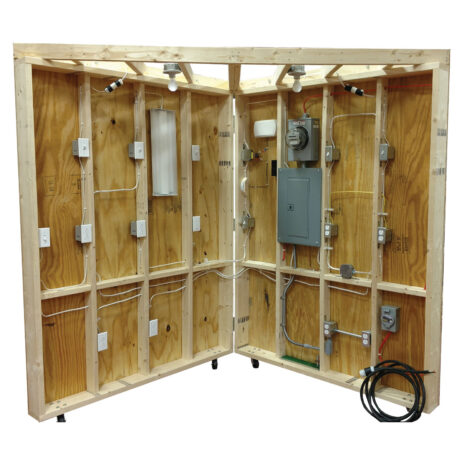Joey Henderson, a 30-year HVAC veteran, and product development leader Nick Goode give valuable advice on how to upgrade your program’s residential wiring course. Through their six key lessons, HVAC/R students get hands-on experience with residential electricity using iConnect Training’s TUE-200 Residential Wiring Training Unit.
 Lesson #1: The Residential Wiring Components
Lesson #1: The Residential Wiring Components
Instructors should familiarize their students with all the components of the TUE-200 simulator. These include:
- Power feed to the whole system with two hots, a neutral and a ground
- Power meter
- Stud wall
- Circuit breaker panel with circuit breakers
- Single-pole switches
- 3-way switches
- Different amp ratings receptacles
- Dryer receptacle or 240-volt receptacle
- Low-voltage transformer running a doorbell system
- 3-way switch operating a light
- Ceiling lights
- Various switches powering more duplexes with the tabs on the side broken off that shows how to keep one hot all the time and operate the other one with a switch
Lesson #2: The Electrical Panel and How It Distributes the L1 and L2 Coming Into It
With this lesson, students learn how to use their meter, measure voltage and become more comfortable around high voltage.
First, locate grounding inside the electrical panel behind the cover where all the breakers are. Students can see how different power comes in from the home’s transformer. From L1 to ground, 120- to 124-volts are produced which is enough to power outlets and lights. To run larger loads like a dryer, both sides of the meters are used to generate 208- or 240-volts.
Lesson #3: How the Single-Pole and Double-Pole Work
Future technicians must know the difference between a single-pole and double-pole.
At this time, instructors can point out that a breaker trips whenever it gets too hot because the current load going through it is too high. If there’s too much amperage through the wire to the breaker, then that breaker protects the wire from overheating and causing a house fire. It also protects the outlet from overheating.
Lesson #4: The Path of Electricity From the Panel
It’s important for future technicians to understand the flow of electricity out of the panel. They simply follow the red and black wires coming from the breaker and out the bottom of the box. It then goes through the stud wall, stapled up the same wall and mounted on the back panel.
Lesson #5: How to Measure Voltages
Students should get hands-on experience measuring the voltages at each outlet as well as the double-poles.
This is a great time to explain that each wire has its own size; and the larger the number of the gauge of wire, the smaller it is and the less current it can handle. Instructors can also introduce the different types of conduits including:
- Hard conduit
- Corrugated metal conduit
- Remox wire going through the walls inside of a single sheet
Lesson #6: A 3-Way Switch and a Single-Switch
During this lesson, a diagram can be displayed to help describe the 3-way switch. Then, let students gain experience by powering down the trainer and having them wire it back up. Instructors can go over the single-switch and how to utilize the broken tabs to keep outlets hot at all times.
Lesson #7: How to Calculate Watts
Using a heat gun, instructors can show how the meter will increase speed as more wattage is used. This is a great opportunity to explain how volts times amps equals watts. Students measure voltage in the heat gun outlet and measure amperage pulling on the circuit itself. They’ll come up with the actual wattage and see how fast the meter is spinning.
Request a Quote for the TUE-200 Residential Wiring Training Unit
Want to incorporate this training unit into your lesson plan? Give us a call today at 716-699-2031 or request a quote https://iconnecttraining.com/contact/.